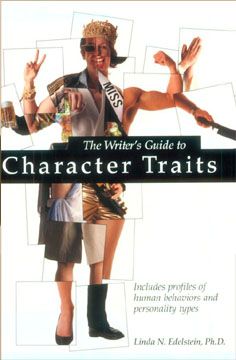
THE WRITER'S GUIDE TO CHARACTER TRAITS by Linda N. Edelstein (a book review by L McKenna Donovan) Your hands are poised over the keyboard. Your main character has just said something incredibly clever. You have the next New York Times bestseller right there under your fingertips: tension is rising, the pace has picked up, your readers leaning forward in their chairs, and then... ...you don't know 'what next'. You know what you want your character to do (or not), what you want your reader to feel, but is it 'true' to your character? What would your serial killer be most likely to do next? Wash her hands? Buy himself an Armani three-piece suit? Is this a familiar conundrum for you? To write that next believable action, mannerism, clever repartee or internal thought, have you wondered if you should have a degree in psychology or sociology? How many times have you heard the phrase, 'write what you know' then made that little leap in your mind that says, 'but I want to know it all! How many of us have the luxury of time, money and location to get that Ph.D in psychology? Linda N. Edelstein, a practicing psychologist for 15 years, has provided the writing community with an excellent layman's psychological reference guide to personalities a way to get inside the head and heart of your character, whether they are a soccer parent or a serial killer. "Even when a writer's imagination soars to places more fascinating than reality, characters must possess an internal cohesiveness: They must make sense," says Linda N. Edelstein in her book. The Writer's Guide to Character Traits includes profiles of human behaviors and personality types. Character can be consistent and believable, yet hold surprises. Make no mistake The Writer's Guide to Character Traits is not a cookie cutter for creating characters. Edelstein makes the statement that "people are more consistent than not", but the cross-referencing of behaviors allows the writer to create multi-dimensional characters with surprising twists and quirks. She explains: "Character is like looking at a box I hold up in front of your eyes. You clearly see the side facing you. You can know that segment of the box but you are na ve if you think that one side is all there is. You know that the box has other sides, and you make assumptions about the unseen sections of the box. Some... guesses will be correct...other assumptions will be wrong..." For example, YOUR CHARACTER IS AN ACCOUNTANT (see career personality traits). He seems to be an honest guy, but HE'S REALLY ON THE TAKE, embezzling funds from unsuspecting clients (see profiles of white collar criminals). Due to his ADDICTIVE PERSONALITY (see adult disorders), he's racked up quite a GAMBLING debt (see traits of risk takers). However, you the reader have to feel sorry for him, since his behavior is greatly influenced by his CHILDHOOD (see child disorders; see group influences). His father was ABUSIVE (see traits of abusers and their victims) and his mother, a shameless SOCIAL CLIMBER (see adult personality traits) taught him that money was everything. Could all of this drive him OVER THE EDGE? (see extreme behaviors). Could he even be capable of MURDER to hide his deeds? (see profiles of violent criminals). CAN HE CHANGE HIS WAYS? (see treatments) IS IT POSSIBLE FOR HIM TO FIND LOVE, in spite of his problems? (see traits of love and marriage). ~paraphrased from The Writer's Guide to Character Traits by Linda N. Edelman An excellent reference for picking up and exploring, The Writer's Guide to Character Traits. does not require a front-to-back reading. Edelstein has divided this reference into thirteen gulpable chapters. With a touch of down-to-earth, she includes The Big Index , which lists the entire contents of the book in five sections: Styles, Adult Normal; Styles, Adult Problems; Styles and Symptoms, Child Problems; Traits (Emotions, Personality Characteristics, Behaviors, and Attitudes); and Physical Disorders and Symptoms. Just remember: this is not a prescription for human behavior which limits the writer to stereotypes, but rather a springboard into the pool of life from which to create the character of your New York Times bestseller! Enjoy!
© 2001 L McKenna Donovan Bonfire contributor |